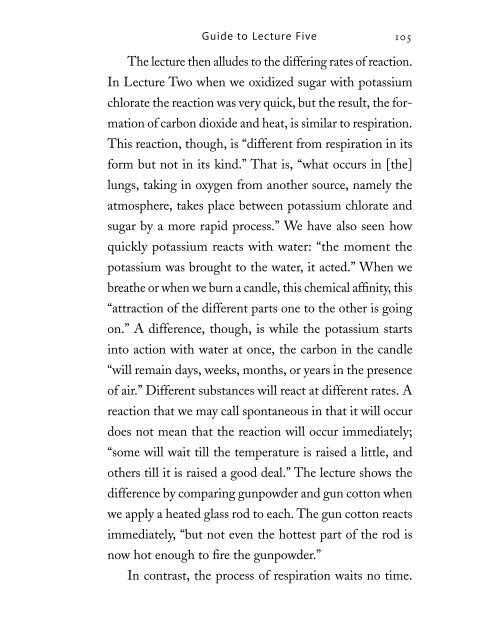Michael Faraday's The Chemical History of a Candle
Michael Faraday's The Chemical History of a Candle With Guides to Lectures, Teaching Guides & Student Activities by Bill Hammack & Dos DeCoste
Michael Faraday's The Chemical History of a Candle With Guides to Lectures, Teaching Guides & Student Activities by Bill Hammack & Dos DeCoste
You also want an ePaper? Increase the reach of your titles
YUMPU automatically turns print PDFs into web optimized ePapers that Google loves.
Guide to Lecture Five<br />
105<br />
<strong>The</strong> lecture then alludes to the differing rates <strong>of</strong> reaction.<br />
In Lecture Two when we oxidized sugar with potassium<br />
chlorate the reaction was very quick, but the result, the formation<br />
<strong>of</strong> carbon dioxide and heat, is similar to respiration.<br />
This reaction, though, is “different from respiration in its<br />
form but not in its kind.” That is, “what occurs in [the]<br />
lungs, taking in oxygen from another source, namely the<br />
atmosphere, takes place between potassium chlorate and<br />
sugar by a more rapid process.” We have also seen how<br />
quickly potassium reacts with water: “the moment the<br />
potassium was brought to the water, it acted.” When we<br />
breathe or when we burn a candle, this chemical affinity, this<br />
“attraction <strong>of</strong> the different parts one to the other is going<br />
on.” A difference, though, is while the potassium starts<br />
into action with water at once, the carbon in the candle<br />
“will remain days, weeks, months, or years in the presence<br />
<strong>of</strong> air.” Different substances will react at different rates. A<br />
reaction that we may call spontaneous in that it will occur<br />
does not mean that the reaction will occur immediately;<br />
“some will wait till the temperature is raised a little, and<br />
others till it is raised a good deal.” <strong>The</strong> lecture shows the<br />
difference by comparing gunpowder and gun cotton when<br />
we apply a heated glass rod to each. <strong>The</strong> gun cotton reacts<br />
immediately, “but not even the hottest part <strong>of</strong> the rod is<br />
now hot enough to fire the gunpowder.”<br />
In contrast, the process <strong>of</strong> respiration waits no time.


